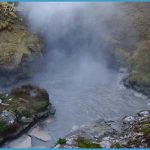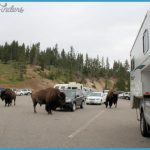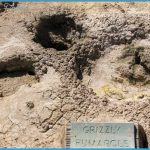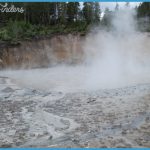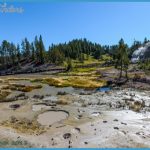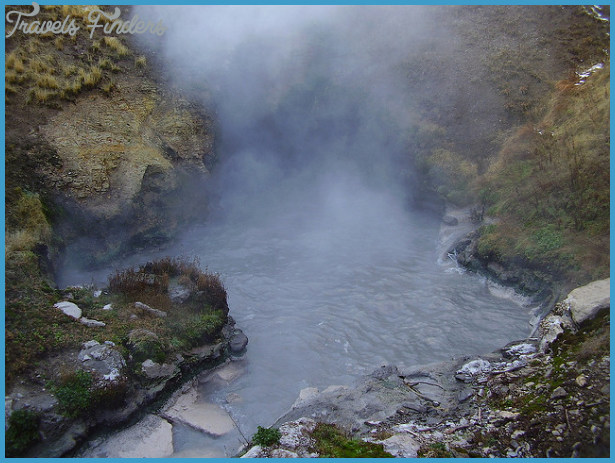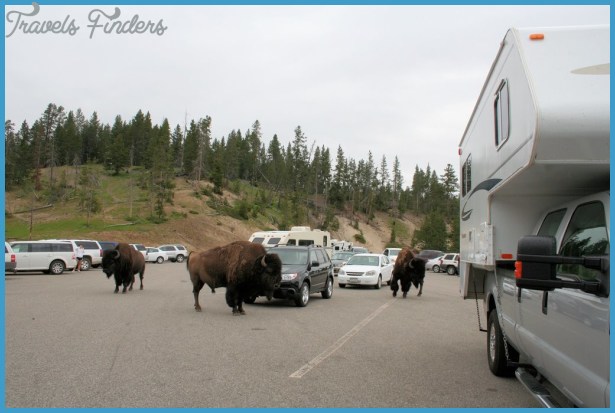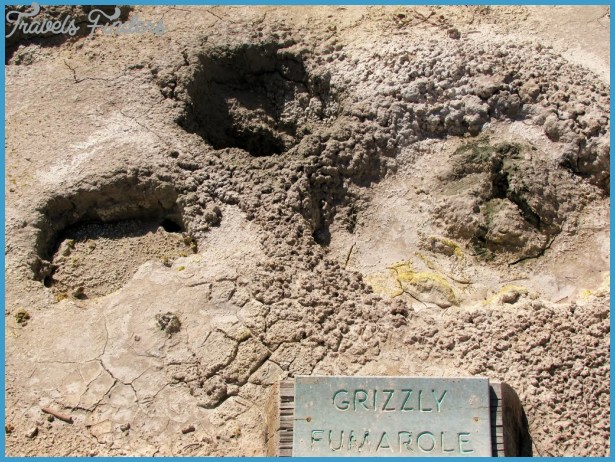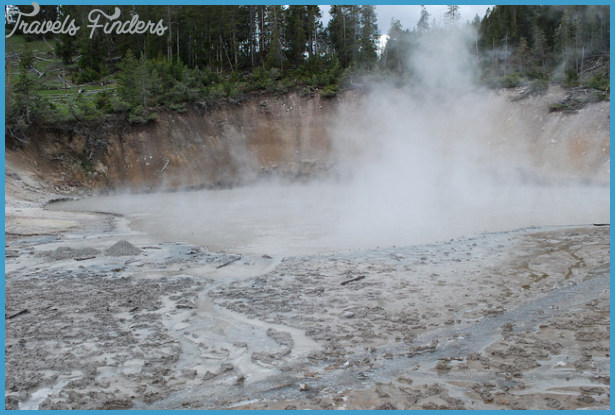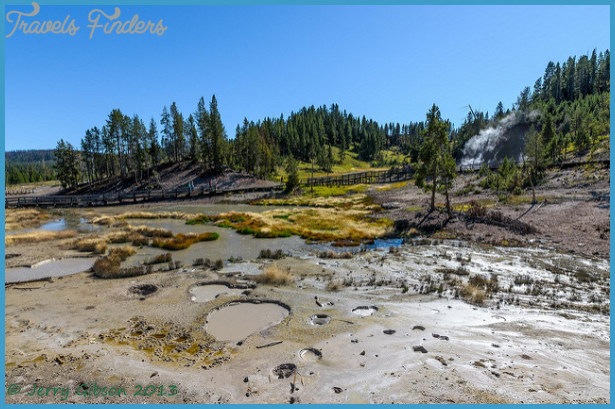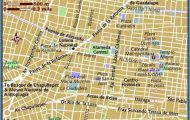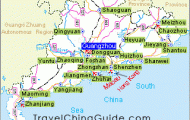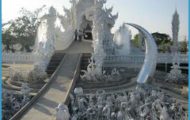Mud Volcano Walk This trail loops around all the features in less than one mile (1.5 km). The climb is a little more gradual going clockwise (starting to your left). NOTE: © Only the north length of boardwalk, which includes Dragon’s Mouth Spring, is wheelchair-accessible, since there are steps above Mud Volcano. The first feature encountered, Mud Geyser, viewed from above, was a spectacular geyser when the park was first explored. It erupted to 40 or 50 feet (12-15 m) from its large pool and then drained dramatically. It’s now usually a bubbling muddy lake with rare eruptions. You can see evidence here that the soil is now too hot for any trees to grow. Some years ago a surge of local earthquake activity caused changes, including an increase in soil temperature that killed lodgepole pines, which were then blown down all around. The increased heat also created the Cooking Hillside, where the trail goes uphill.
Sizzling Basin and Churning Caldron (up the hill) were affected, too. Sizzling Basin used to sizzle more than it does now, while Churning Caldron is now too hot for bacteria to form. The newest large feature, south of the main walkway, is a seething mud pot, Black Dragon’s Caldron, which formed in the winter of 1947-48. It must have begun with a terrific explosion, because trees were blown out by their roots, but no one happened to be here to see it. The pool has since grown much larger: it’s about 200 feet (60 m) long. Hydrogen sulfide bubbles to the surface, causing the rotten egg smell. The black color (or sometimes a deep gray when there’s lots of water) is due to iron sulfides. Huge and very acid Sour Lake beyond Black Dragon’s Caldron is less hot than some of its neighbors, allowing bacteria and algae to thrive and color the water green. As you can see from the steam rising beyond Sour Lake, there are more thermal features where the boardwalk doesn’t go. Please don’t leave the boardwalk unless you’re with a ranger. The walkway crosses quiet meadow and forest, where you may see wildlife before reaching Grizzly Fumarole. This feature changes seasonally from a large, spattering mud pot to some quiet, steaming holes, depending upon its water supply.
Mud Volcano is reached by boardwalk today, but in 1870, when the Washburn exploration party named it, there was only a steep hillside. Those who climbed the hill saw a cone from which mud splashed into the trees as much as 100 feet up and 200 feet away (30 and 60 m). It made a tremendous racket. However, only two years later, Superintendent Langford returned to find that the loud detonations which resembled the discharges of a gun-boat mortar were no longer heard, and the upper part of the crater and cone had in a great measure disappeared, leaving a shapeless and unsightly hole much larger than the former crater . Today, Mud Volcano’s dark gray water continues to bubble and churn inside a deep hole at the base of the hillside. Dragon’s Mouth Spring is still fun to visit, although its activity has diminished in recent years. The belching waters from deep within its cavern make an amazing thumping sound. You may be mesmerized by the sound and the repetition of the surging action. Acid Hot Springs The Mud Volcano area and Norris Geyser Basin are the two easily accessible thermal basins that have great concentrations of acid hot springs. Sulphur Caldron, across the road and just north of here, has water that is more acidic than lemon juice (with a pH of 1.3).
So much acid and sulfur in the water prevent the growth of multicolored bacteria and algae seen elsewhere. Can you believe that anything can live in such an environment? Surprisingly, at least one microbe (Sulfolobus acidocaldarius) thrives here and actually feeds upon sulfur compounds such as hydrogen sulfide. It oxidizes the sulfur, turning it into sulfuric acid. Formerly classified as a bacterium, Sulfolobus has recently been found to belong to the domain Archaea, earth’s oldest known organisms. It is quite content in Yellowstone, growing well even at the amazingly high temperature of 194°F (90°C). These acidic pools and soils also harbor a more complex organism, a type of alga (Cyanidium caldarium) that grows only in acid conditions and lives at temperatures up to 133°F (57°C). In the backcountry less than a mile from here, microbiologists have found a very hot pool with a diversity of life forms hitherto unimagined. Conducting studies in Yellowstone, scientists continue to learn about some of the oldest forms of life on earth.

